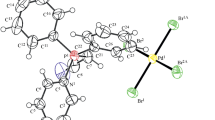Abstract
Tetrapalladium clusters containing dppa or dppa and dppm bridging ligands were prepared by condensation of dinuclear units. Reaction of [Pd2Cl2(μ-dppa)2] with [Cu(PPh3)]PF6 (generated in situ in THF) yielded [Pd4(μ-Cl)2(μ-dppa)4] (PF6)2 (4) in a virtually quantitative yield but [Pd4(μ-Cl)2(μ-dppm)2(μ-dppa)2] (PF6)2 (6) was best prepared in CH2Cl2 from [Pd2Cl2(μ-dppm)2] and [Pd2(MeCN)2(μ-dppa)2](PF6)2 (2). The structure of 6·2(CH3)2CO·2H2O was determined by X-ray diffraction. It consists of a planar, centrosymmetric 10-membered ring structure. The four bridging diphosphine ligands are of two types: two dppa ligands support the Pd Pd bonds [2.6055(4) Å], whereas the two dppm ligands bridge between two palladium atoms separated by 3.722(4) Å, which are also bridged by a chloride ligand.
Similar content being viewed by others
REFERENCES
P. Braunstein and J. Rosé (1984). J. Organomet. Chem. 262, 223. (b) P. Braunstein, J. Rosé, A. Tiripicchio, and M. Tiripicchio Camellini (1984). J. Chem. Soc. Chem. Commun. 391. (c) P. Braunstein, H. Lehner, D. Matt, A. Tiripicchio, and M. Tiripicchio Camellini (1984). Angew. Chem. Int. Ed. Engl. 23, 304. (d) P. Braunstein, J. Rosé, A. M. Manotti-Lanfredi, A. Tiripicchio, and E. Sappa (1984). J. Chem. Soc. Dalton Trans. 1843. (e) P. Braunstein, J. Rosé, A. Tiripicchio, and M. Tiripicchio Camellini (1985). Angew. Chem. Int. Ed. Engl. 24, 767. (f) P. Braunstein, J. Rosé, A. Dedieu, Y. Dusausoy, J.-P. Mangeot, A. Tiripicchio, and M. Tiripicchio Camellini (1986). J. Chem. Soc. Dalton Trans. 225. (g) P. Braunstein, T. M. Gomes Carneiro, D. Matt, A. Tiripicchio, and M. Tiripicchio Camellini (1986). Angew. Chem. Int. Ed. Engl. 25, 748. (h) P. Braunstein, S. Freyburger, and O. Bars (1988). J. Organomet. Chem. 352, C29. (i) T. Blum, P. Braunstein, A. Tiripicchio, and M. Tiripicchio Camellini (1988). New J. Chem. 12, 539. (j) R. Bender, P. Braunstein, A. Dedieu, and Y. Dusausoy (1989). Angew. Chem. Int. Ed. Engl. 28, 923. (k) F. Castagno, M. Castiglioni, E. Sappa, A. Tiripicchio, M. Tiripicchio Camellini, P. Braunstein, and J. Rosé (1989). J. Chem. Soc. Dalton Trans. 1477. (l) T. Blum and P. Braunstein (1989). Organometallics 8, 2497. (m) P. Braunstein, E. de Jésus, M. Lanfranchi, A. Tiripicchio, and F. Ugozzoli (1992). Inorg. Chem. 31, 411. (n) P. Braunstein, J. Rosé, A. Tiripicchio, and M. Tiripicchio Camellini (1992). J. Chem. Soc. Dalton Trans. 911. (o) M. Knorr, T. Faure, and P. Braunstein (1993). J. Organomet. Chem. 447, C4. (p) P. Braunstein, M. Knorr, T. Stährfeldt, A. DeCian, and J. Fischer (1993). J. Organomet. Chem. 459, C1. (q) C. Archambault, R. Bender, P. Braunstein, A. DeCian, and J. Fischer (1996). J. Chem. Soc. Chem. Commun. 2729.
P. Braunstein, M. A. Luke, A. Tiripicchio, and M. Tiripicchio Camellini (1987). Angew. Chem. Int. Ed. Engl. 26, 768.
Preliminary electrochemical data on [Pd4(µ-Cl)2(µ-dppm)4](BF4)2 indicate two different, irreversible reduction steps in CH2Cl2 (platinum electrode). They occur at E p = −1.07 and E p = −1.55 V (vs saturated calomel electrode). Controled potential coulometry (at the first step) involves four electrons/molecule. The irreversible behavior of the cathodic processes was confirmed by the degradation of the molecule after exhaustive electrolysis (P. Zanello and M. Fontani, personal communication, 1998).
P. Braunstein, M. A. Luke, A. Tiripicchio, and M. Tiripicchio Camellini (1988). New J. Chem. 12, 429.
I. Bachert, P. Braunstein, and R. Hasselbring (1996). New J. Chem. 20, 993. (b) I. Bachert, P. Braunstein, M. K. McCart, F. Fabrizi de Biani, F. Laschi, P. Zanello, G. Kickelbick, and U. Schubert (1999), J. Organomet. Chem. 573, 47.
J. T. Mague (1995). J. Cluster Sci. 6, 217. (b) P. Bhattacharyya and J. D. Woollins (1995). Polyhedron 14, 3367.
C. S. Browning, D. H. Farrar, D. C. Frankel, and J. J. Vittal (1997). Inorg. Chim. Acta 254, 329.
H. Nöth and E. Meinel (1967). Z. Anorg. Allg. Chem. 349, 744. (b) H. Nöth and E. Fluck (1984). Z. Naturforsch. 39b, 225.
H. Schmidbaur, G. Reber, A. Schier, F. E. Wagner, and G. Müller (1988). Inorg. Chim. Acta 147, 143.
M. Maekawa, M. Munakata, T. Kuroda-Sowa, and T. Goto (1995). Inorg. Chim. Acta 239, 159.
A. L. Balch, L. S. Benner, and M. M. Olmstead (1979). Inorg Chem. 18, 2996.
R. Uson, J. Fornies, P. Navarro, M. Tomas, C. Fortuño, J. I. Cebollado, and A. J. Welch (1989). Polyhedron 8, 1045.
OpenMoleN, Interactive Structure Solution (Nonius B. V., Delft, The Netherlands, 1997).
D. T. Cromer and J. T. Waber, International Tables for X-Ray Crystallography, Vol. IV (Kynoch Press, Birmingham, 1974), (a) Table 2.2b, (b) Table 2.3.1.
Author information
Authors and Affiliations
Rights and permissions
About this article
Cite this article
Bachert, I., Braunstein, P., Guillon, E. et al. Synthesis of Palladium Clusters with the P--N--P Assembling Ligands (Ph2P)2CH2 (dppm) and (Ph2P)2NH (dppa). Crystal Structure of [Pd4(μ-Cl)2(μ-dppm)2(μ-dppa)2](PF6)2 . Journal of Cluster Science 10, 445–458 (1999). https://doi.org/10.1023/A:1022633211521
Issue Date:
DOI: https://doi.org/10.1023/A:1022633211521



